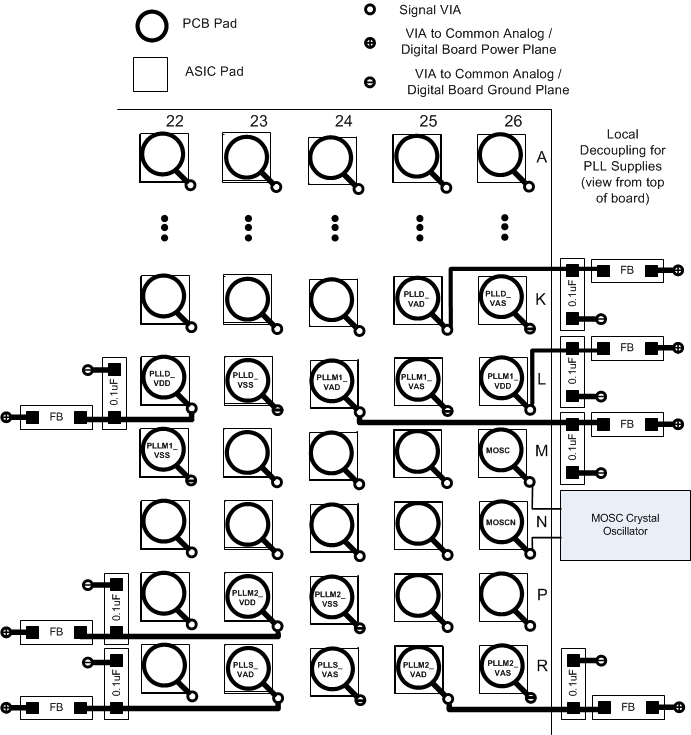ZHCSD20G October 2014 – November 2023 DLPC900
PRODUCTION DATA
- 1
- 1 特性
- 2 应用
- 3 说明
- 4 Pin Configuration and Functions
-
5 Specifications
- 5.1 Absolute Maximum Ratings
- 5.2 ESD Ratings
- 5.3 Recommended Operating Conditions
- 5.4 Thermal Information
- 5.5 Electrical Characteristics
- 5.6 System Oscillators Timing Requirements #GUID-909D0FD3-84C7-4481-924A-4FDE7EB548A1/DLPS0373944
- 5.7 Power-Up and Power-Down Timing Requirements
- 5.8 JTAG Interface: I/O Boundary Scan Application Timing Requirements
- 5.9 JTAG Interface: I/O Boundary Scan Application Switching Characteristics
- 5.10 Programmable Output Clocks Switching Characteristics
- 5.11 Port 1 and 2 Input Pixel Interface Timing Requirements
- 5.12 Two Pixels Per Clock (48-Bit Bus) Timing Requirements
- 5.13 Synchronous Serial Port (SSP) Switching Characteristics
- 5.14 DMD Interface Switching Characteristics #GUID-A1639D57-2918-4D83-ADD0-B21B369F4B9B/DLPS0379327
- 5.15 DMD LVDS Interface Switching Characteristics
- 5.16 Source Input Blanking Requirements
-
6 Detailed Description
- 6.1 Overview
- 6.2 Functional Block Diagram
- 6.3
Feature Description
- 6.3.1 DMD Configurations
- 6.3.2 Video Timing Input Blanking Specification
- 6.3.3 Board-Level Test Support
- 6.3.4 Two Controller Considerations
- 6.3.5 Memory Design Considerations
- 6.4 Device Functional Modes
-
7 Application and Implementation
- 7.1 Application Information
- 7.2
Typical Applications
- 7.2.1 Typical Two Controller Chipset
- 7.2.2 Typical Single Controller Chipset
- 8 Power Supply Recommendations
-
9 Layout
- 9.1
Layout Guidelines
- 9.1.1 General PCB Recommendations
- 9.1.2 PCB Layout Guidelines for Internal Controller PLL Power
- 9.1.3 PCB Layout Guidelines for Quality Video Performance
- 9.1.4 Recommended MOSC Crystal Oscillator Configuration
- 9.1.5 Spread Spectrum Clock Generator Support
- 9.1.6 GPIO Interface
- 9.1.7 General Handling Guidelines for Unused CMOS-Type Pins
- 9.1.8 DMD Interface Considerations
- 9.1.9 PCB Design Standards
- 9.1.10 Signal Layers
- 9.1.11 Trace Widths and Minimum Spacing
- 9.1.12 Trace Impedance and Routing Priority
- 9.1.13 Power and Ground Planes
- 9.1.14 Power Vias
- 9.1.15 去耦合
- 9.1.16 Fiducials
- 9.2 Layout Example
- 9.3 Thermal Considerations
- 9.1
Layout Guidelines
- 10Device and Documentation Support
- 11Revision History
- 12Mechanical, Packaging, and Orderable Information
9.1.2 PCB Layout Guidelines for Internal Controller PLL Power
The following are guidelines to achieve desired controller performance relative to internal PLLs:
The DLPC900 contains four PLLs (PLLM1, PLLM2, PLLD, and PLLS), each of which have a dedicated 1.15 V digital supply; three of these PLLs (PLLM1, PLLM2, and PLLD) have a dedicated 1.8 V analog supply. It is important to have filtering on the supply pins that covers a broad frequency range. Each 1.15 V PLL supply pin must have individual high frequency filtering in the form of a ferrite bead and a 0.1 µF ceramic capacitor. These components must be located very close to the individual PLL supply balls. The impedance of the ferrite bead should far exceed that of the capacitor at frequencies above 10 MHz. The 1.15 V to the PLL supply pins must also have low frequency filtering in the form of an RC filter. This filter can be common to all the PLLs. The voltage drop across the resistor is limited by the 1.15 V regulator tolerance and the DLPC900 voltage tolerance. A resistance of 0.36 Ω and a 100 µF ceramic are recommended. Figure 9-1 shows the recommended filter topology.
 Figure 9-1 Recommended Filter Topology for PLL 1.15-V Supplies
Figure 9-1 Recommended Filter Topology for PLL 1.15-V SuppliesThe analog 1.8-V PLL power pins must have a similar filter topology as the 1.15-V. In addition, it is recommended that a dedicated linear regulator generates the 1.8-V. Figure 9-2 shows the recommended filtering topology.
 Figure 9-2 Recommended Filter Topology for PLL 1.8-V Supplies
Figure 9-2 Recommended Filter Topology for PLL 1.8-V SuppliesWhen designing the overall supply filter network, care must be taken to ensure no resonance occurs. Specific care is required around the 1- to 2-MHz band, as this coincides with the PLL natural loop frequency.
 Figure 9-3 High Frequency Decoupling
Figure 9-3 High Frequency DecouplingHigh-frequency decoupling is required for 1.15-V and 1.8-V PLL supplies and must be provided as close as possible to each of the PLL supply package pins as shown in Figure 9-3. Placing decoupling capacitors under the package on the opposite side of the board is recommended. High-quality, low-ESR, monolithic, surface-mount capacitors are recommended for use. Typically, 0.1 µF for each PLL supply should be sufficient. The length of a connecting trace increases the parasitic inductance of the mounting, and thus, where possible, there can be no trace, allowing the via to butt up against the land. Additionally, the connecting trace must be made as wide as possible. Further improvement can be made by placing vias to the side of the capacitor lands or doubling the number of vias.
The location of bulk decoupling depends on the system design.